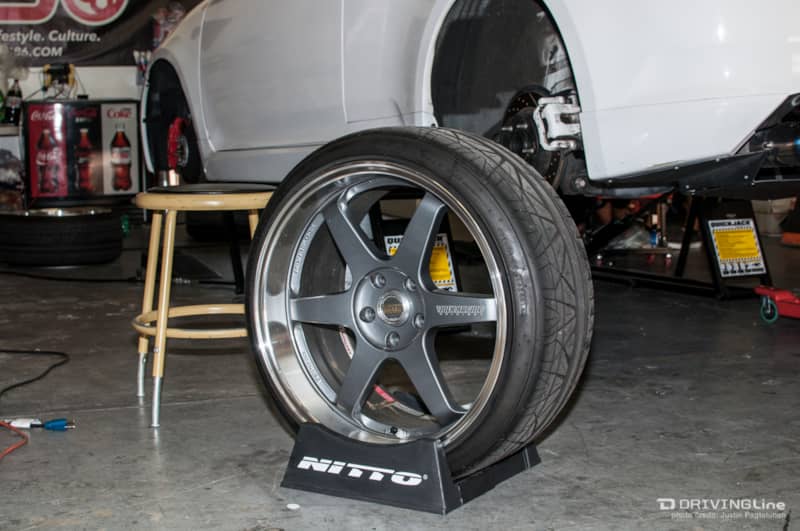Idiot's Guide to Wheel Fitment
You have no idea how many times I've heard "Will [insert wheel here] fit?" It's the age-old question in the import/stance world, especially for newcomers. While there's some trial-and-error involved, and a lot of asking questions, you've got to use some math too if you want to get it right with the least amount of mistakes. I know what you're thinking, "I'm a tough guy, I don't need math." Maybe you're right, maybe tough guys don't do math; tough guys deep-fry chicken for a living. Well whether you're a tough guy or not, all you need are the math basics with this guide. So don't worry, I've kept it simple; I've even color coded it so you can keep everything matched up. By the end of this you will be able to stand and deliver wheel fitment answers like nobody's business.
Put simply, to find if your wheels will fit your car, measure the distance from your wheel’s center point to where it is mounted. This is the offset. Add that to half your wheel’s width to find the back space and subtract it to find the front space. Compare this to your wheel well to see if it fits.

Offset 101
The first thing you should understand is the basics of offsets. The textbook definition of offset is "the distance from the hub mounting surface to the center line of the wheel." But what does that really mean? Let’s use my Volk Racing TE37 TTA in 19x10 +35 as an example for this tutorial.

Since my wheel is 10" wide, then the center line will be at the 5" mark, simple enough. Now offset is measured in millimeters (remember this, it's very important!), so at the center line we are at 0mm or 0 offset.

If we move toward the hub/away from the face we are going into negative offsets. If we move toward the face/away from the hub, like how my wheel is, we are looking at positive offsets. As you can see here, my wheel's mount is 35mm away from the center line or +35 offset. When you're trying to get these measurements right, you might find using a piece of cardboard, as I am below, or anything else laying around the garage makes the job a little easier and more precise.

Know Your Space
Now that you've got the basics of offsets down, let's move on to trying to figure out, "will it fit?" The next two things you need to understand are back space and front space. You will need to know back space to know how far the back of the wheel will go in, preferably without rubbing on the suspension or any other components that might be under the fender. Front space is needed so you know how far the wheel comes out from the hub. In this case, you don't want it to come out past the fender. There are ways to get by this; like fender rolling, cutting fenders, or if the vehicle is raised high enough that the fender goes right over the wheel (and tire), but that's a whole other story.

The trickiest part is making calculations between millimeters, for offset, and inches, for wheel width. To bring everything to the same unit, I will be using centimeters:
1cm = 10mm 2.54cm = 1in
Let's find the center line in centimeters:
Center line in cm = (Wheel width in inches x 2.54) ÷ 2
Using my wheel as an example:
First we convert the wheel width into centimeters: 10in x 2.54 = 25.4cm And then divide that in half to find the center line: 25.4cm ÷ 2 = 12.7cm
Here is the formula for back space with an example:
Center line in cm + offset in cm = Back space 12.7cm + 3.5cm = 16.2cm
And here is the formula for front space with an example:
Center line in cm – offset in cm = Front space 12.7cm - 3.5cm = 9.2cm
FUN FACT: Back Space + Front Space = Wheel Width 16.2cm + 9.2cm = 25.4cm (Math is wild huh!?) Now that you're a boss at measuring wheels, it's time to take the ruler to your vehicle and find its limits. Again, let's bring out that cardboard for help. Starting at the face of the hub, measure into the car until you reach a safe area that you know the wheel wont rub up against anything. For my car, it can take a back space of 18.5cm without any problems, so the 16.2cm back space we found earlier is perfect.

For front space we just do the opposite, start at the hub face and measure out to the fender. The front space I need to be flush with the fender is 9.2cm...

Perfect match!

You Got This
The bottom line for most wheel purchases is knowing the maximum back space your vehicle can handle and the back space the wheel you're considering has (center line + offset), that is how you will know if it will fit without rubbing on anything. Now, to know if it fits and looks good, or "flush" you need to know the front space (center line - offset) and get it as close to how much front space your vehicle has; the closer these numbers match, the flusher the wheel will be to the fender. A couple things to keep in mind, tires are usually wider than wheels, so factor that in when measuring your space. You should also make sure the wheel has proper clearance for the brake calipers; this is usually only an issue with wheels with a huge lip.
With this basic knowledge you are ready for that stance life, bro.







